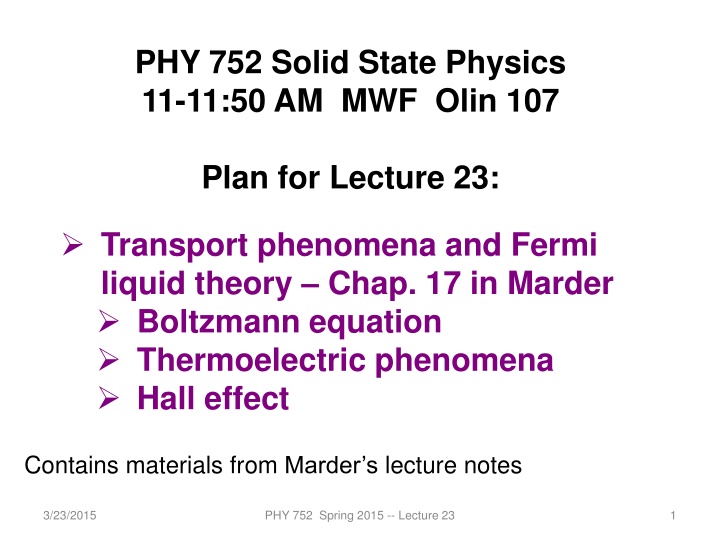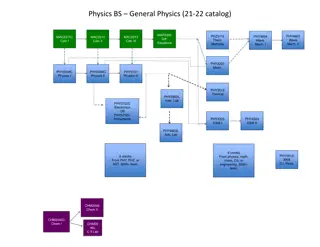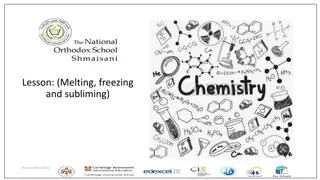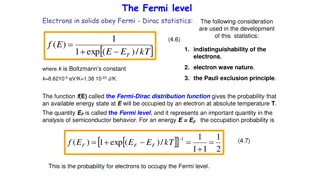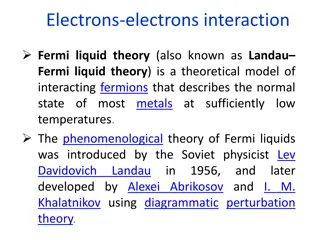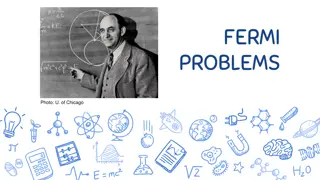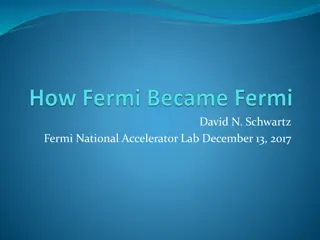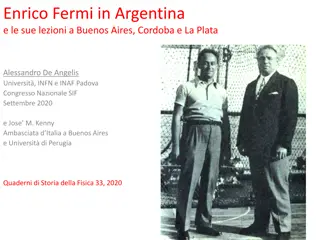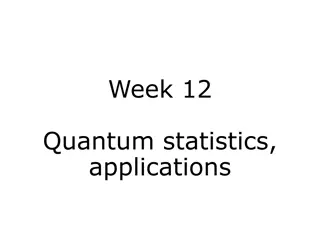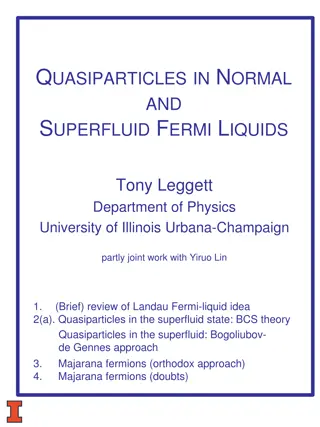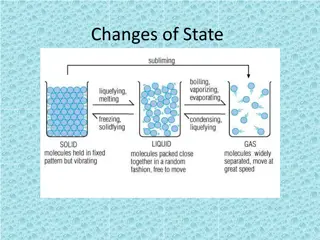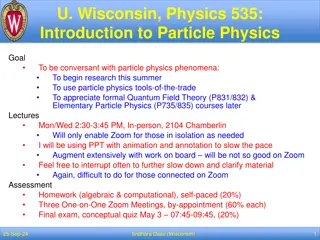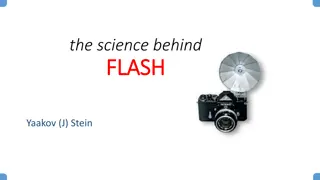Transport Phenomena and Fermi Liquid Theory in Solid State Physics
This lecture delves into the realm of transport phenomena and Fermi liquid theory in solid state physics. Topics covered include the Boltzmann equation, thermoelectric phenomena, the Hall effect, and the distribution function in the context of relaxation time approximation. Theoretical concepts are explored through equations of motion, effective Hamiltonian formulations, and solutions to the Boltzmann equation. Emphasis is placed on understanding the properties and behaviors of electrons within energy bands, as well as the implications of particle interactions on distribution functions.
Download Presentation

Please find below an Image/Link to download the presentation.
The content on the website is provided AS IS for your information and personal use only. It may not be sold, licensed, or shared on other websites without obtaining consent from the author.If you encounter any issues during the download, it is possible that the publisher has removed the file from their server.
You are allowed to download the files provided on this website for personal or commercial use, subject to the condition that they are used lawfully. All files are the property of their respective owners.
The content on the website is provided AS IS for your information and personal use only. It may not be sold, licensed, or shared on other websites without obtaining consent from the author.
E N D
Presentation Transcript
PHY 752 Solid State Physics 11-11:50 AM MWF Olin 107 Plan for Lecture 23: Transport phenomena and Fermi liquid theory Chap. 17 in Marder Boltzmann equation Thermoelectric phenomena Hall effect Contains materials from Marder s lecture notes 3/23/2015 PHY 752 Spring 2015 -- Lecture 23 1
3/23/2015 PHY 752 Spring 2015 -- Lecture 23 2
Using previous results based on wavepacket of Bloch waves with wavevectors near kc k and spatially centered at rc r. Effective Hamitonian with electric and magnetic fields: E k Energy band: ( ) where Equations of motion 3/23/2015 PHY 752 Spring 2015 -- Lecture 23 3
Equations of motion continued: Marder s notation for distribution function: Number of electrons in volume density of states 3/23/2015 PHY 752 Spring 2015 -- Lecture 23 4
Properties of the distribution function: Continuity equation: additional term due to particle interactions Boltzmann s equation: 3/23/2015 PHY 752 Spring 2015 -- Lecture 23 5
Relaxation time approximation to collision term Fermi-Dirac distribution Solution to Boltzmann equation in relaxation time approximation: 3/23/2015 PHY 752 Spring 2015 -- Lecture 23 6
Finding distribution function in relaxation time approximation -- continued Integrating by parts: df dt = + r k f ' ' t t ' r k 3/23/2015 PHY 752 Spring 2015 -- Lecture 23 7
Finding distribution function in relaxation time approximation -- continued E E f k f f f r f T ( ) = = v = E E k E T df dt = + r k f ' ' t t ' r k 3/23/2015 PHY 752 Spring 2015 -- Lecture 23 8
Finding distribution function in relaxation time approximation -- continued If the relaxation time E is faster than the other variables, the integral can be approximated as: 3/23/2015 PHY 752 Spring 2015 -- Lecture 23 9
Application to electrical current in the presence of a uniform electric field 2 2 = Recall that [ ] dk dk 3 V ( 2 ) k 3/23/2015 PHY 752 Spring 2015 -- Lecture 23 10
Application to electrical current in the presence of a uniform electric field -- continued f E E Note that ( ) F Only the Fermi surface contributes to the conductivity 3/23/2015 PHY 752 Spring 2015 -- Lecture 23 11
Application to electrical current in the presence of a uniform electric field -- continued Alternate expression: For isotropic system: where: 3/23/2015 PHY 752 Spring 2015 -- Lecture 23 12
Effects of heat and temperature For a constant volume process, the first law of thermo says Define particle current: Define energy current: External force acting on system 3/23/2015 PHY 752 Spring 2015 -- Lecture 23 13
Effects of heat and temperature continued Rate of entropy production: Rate of heat production 3/23/2015 PHY 752 Spring 2015 -- Lecture 23 14
Effects of heat and temperature continued Heat production per wavenumber and per volume: Connection with Boltzmann distribution in relaxation approximation: 3/23/2015 PHY 752 Spring 2015 -- Lecture 23 15
Calculation of response coefficients General form of response coeffients: 3/23/2015 PHY 752 Spring 2015 -- Lecture 23 16
Responses involving thermal and electrical gradients Electrochemical force: Electrochemical flux: Thermal force: Thermal flux: 3/23/2015 PHY 752 Spring 2015 -- Lecture 23 17
Responses involving thermal and electrical gradients continued Linear coefficients: Note that these can be calculated from: where 3/23/2015 PHY 752 Spring 2015 -- Lecture 23 18
Responses involving thermal and electrical gradients continued Define: Note that: 3/23/2015 PHY 752 Spring 2015 -- Lecture 23 19
Example: Thermal conductivity Consider the case where there is heat flow but no current: 0 j = 3/23/2015 PHY 752 Spring 2015 -- Lecture 23 20
Example: Thermal conductivity -- continued 3/23/2015 PHY 752 Spring 2015 -- Lecture 23 21
Example: Hall effect 3/23/2015 PHY 752 Spring 2015 -- Lecture 23 22
Example: Hall effect -- continued 3/23/2015 PHY 752 Spring 2015 -- Lecture 23 23
Example: Hall effect -- continued 3/23/2015 PHY 752 Spring 2015 -- Lecture 23 24
Example: Hall effect -- continued 3/23/2015 PHY 752 Spring 2015 -- Lecture 23 25
Example: Hall effect -- continued where: 3/23/2015 PHY 752 Spring 2015 -- Lecture 23 26
Example: Hall effect -- continued Hall coefficient: 1 for electron carriers nec = R H 1 for hole carriers pec 3/23/2015 PHY 752 Spring 2015 -- Lecture 23 27
